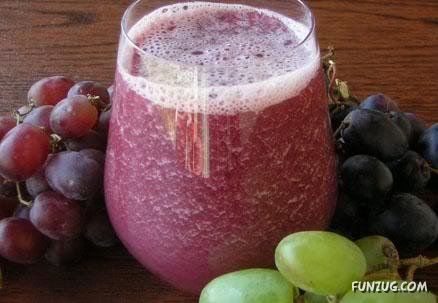
Grapes is a small round or oval fruit, some grapes are seedless. Grapes is a rich source of flavonoids, this gives the gives the vibrant purplish color to grapes , grape juice and the stronger the color, the higher the flavonoid content.( Flavonoids are most commonly known for their antioxidant activity. )
nutritive Values of Grapes : Per 100 gm.
* Vitamin A : 80 I.U.
* Vitamin B : Thiamine .06 mg.;
* Vitamin c : 4 mg.
* Calcium : 17 gm.
* Phosphorus : 21 mg.
* Fat : 1.4 gm.
* Carbohydrates : 14.9 gm.
* Protein : 1.4 gm.
* Calories : 70
Health Benefits of Grapes: 1. Good blood and body builder, it is also a quick source of energy.
2. Grape juice is easily assimilated and called the "nectar of the gods". It is indicated in cases of constipation, gout, rheumatism, skin and liver disorders.
3. This alkaline fruit (also called "the queen of fruits") helps greatly to decrease the acidity of the uric acid and lends itself further in aiding the elimination of the acid from the system, thus benefiting the kidneys greatly.
4. Studies shown that grape juice, red wines and raisin tea showed strong antiviral activity against poliovirus, herpes simplex virus.
5. Helps reduce platelet clumping and harmful blood clots.
How to Make Fresh Grape Juice?? 
When you think of grape juice, concord grapes, the grape traditionally used to make conventional grape juice, might come to mind. This variety is absolutely wonderful for making delicious raw grape juice, but isnít the only choice.
Grapes are a diverse bunch, available in multiple colors [green, red, amber, blue-black, purple], varying in taste [sweet, dry, tart], texture, and size. Among these varieties, certain grapes are said to be best suited for certain uses. There are wine grapes [best used to produce wine], raisin grapes [dried to make raisins], and table grapes [best eaten as is or used in a recipe] Ė but donít let this information limit you from trying each type of grape, regardless of its designated use, or varieties like Muscadine or Scuppernong.
The naturally sweet taste of fresh-juiced grapes alone is enough to sell me on the idea of making this beautiful drink, and its healthful nutrients [antioxidants Ė vitamin C, flavonoids, vitamin B1 and B6, manganese, and potassium] only adds to its appeal.
Fresh Mixed Grape Juice
Iíve used both seedless and seeded grapes. I especially like the idea of receiving the added bonus of fresh grape seed extract from the crushed seeds of the seeded grapes!
1/3 cup organic black grapes
1/3 cup organic red grapes
1/3 cup organic green grapes
ľ cup filtered water, optional
Remove grapes from the stems. Place the grapes in a bowl under running water to wash and strain the water from the grapes.
Run the grapes in batches through a juicer. Add water, if desired, and stir.
If using a blender [ideally a high-speed blender], add the grapes and Ĺ cup filtered water to the blender container. Blend until liquefied. Pour the juice through a fine mesh sieve or cheesecloth to strain and remove the pulp and any seed particles.
Serve immediately or chill in the refrigerator until ready to serve.
Serves 1 Ė 2, depending on the size of the glass.
Note: Seedless white/green grapes offer a light subtle flavor in comparison to the sweet rich flavor of red grapes.
Fresh raw grape juice, as well as most fresh raw juice is extremely sensitive to fermentation, even when refrigerated. This is one reason why it is best to drink freshly made juice soon after it is made.
 LIFE & STYLE
LIFE & STYLE Recipe Corner
Recipe Corner Beverages
Beverages How to Make Fresh Grape Juice?
How to Make Fresh Grape Juice? LIFE & STYLE
LIFE & STYLE Recipe Corner
Recipe Corner Beverages
Beverages How to Make Fresh Grape Juice?
How to Make Fresh Grape Juice?
